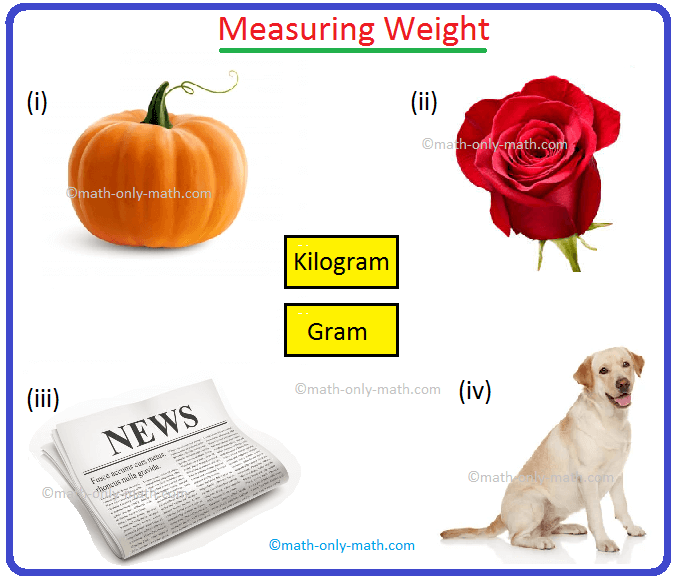Subscribe to our ▶️ YouTube channel 🔴 for the latest videos, updates, and tips.
Unit of Mass or Weight
The
set of standard units of measurement which is widely used is known as Metric
System.
We know the main standard unit of mass or weight is kilogram which we write in short as ‘kg’. 1000th part of this kilogram is gram which is written in short as ‘g’.
Thus 1000 gram = 1 kilogram and 1 kilogram = 1000 gram
i.e. 1000 g = 1 kg and 1 kg = 1000 g.
This gram (g) is a very small unit of mass.
The standard unit of mass in the metric system in gram. To weigh lighter objects like biscuits, popcorn, etc, we use grams. To measure weights smaller than 1 gram like medicines, we can use milligrams (mg). 1 milligram is equal to one-thousandth of a gram.
1000 milligrams (mg) = 1 gram (g)
1000 grams (g) = 1 kilogram (kg)
We use other units of mass or weight to conveniently measure the mass or weight of materials.
|
1/2 of 1 kg = 500 grams |
or 2 x 500 grams = 1 kg |
So, 1 kg, 500 g, 250 g, 200 g, 100 g, 50 g, etc. are the different units for measuring the mass or weight.
There are also the unit weights for measuring 5 kg, 10 kg, 20 kg, 50 kg and 100 kg mass.
100kg wt. is called one quintal wt.
10 quintal wt. is known as one metric ton.
Thus 1 Quintal = 100 kg and 100 kg = 1 quintal.
1 metric ton = 10 quintal = 10 x 100 kg = 1000 kg
We can say there are three main units of mass. To weigh heavy
things, we use the unit metric ton (1000 kg) or quintal (100 kg) and to
weigh the things of our general use we adopt kilogram and gram.
Thus very heavy objects are weighed in quintal and metric ton, heavy
objects are weighed in kilogram and light objects are weighed in gram.
We use the weights of 500g, 250g, 200g, 100g, 50g, 25g, etc.
The things are weighed with the help of a balance. Generally this balance is called a common balance. We place the weight in one pan and the objects or commodities in the other pan.
Common Balance
Units of Weight:
|
10 10 milligrams (mg) |
= |
1 centigram (cg) |
|
10 centigrams (cg) |
= |
1 decigram (dg) |
|
10 decigrams (dm) |
= |
1 gram (g) |
|
10 grams (g) |
= |
1 decagram (dag) |
|
10 decagrams (dag) |
= |
1 hectogram (hg) |
|
10 hectograms (hg) |
= |
1 kilogram (kg) |
1 gram is taken as the basic unit of measuing weight.
|
1 dag |
= |
10 g |
|
1 hg |
= |
100 g |
|
1 kg |
= |
1000 g |
|
1 dg |
= |
\(\frac{1}{10}\) g |
|
1 cg |
= |
\(\frac{1}{100}\) g |
|
1 mg |
= |
\(\frac{1}{1000}\) g |
Worksheet on Unit of Mass or Weight:
We know that the mass of an object is measured in kilograms and grams. Kilogram is a bigger unit of mass and is used to measure weights of heavier objects. Gram is used for measuring lighter objects.
We have also learnt conversion of one unit to another. We can convert kilogram into grams by multiplying the number of kilograms by 1000. To convert grams into kilograms, we divide the number of grams by 1000.
I. Fill in the blanks:
(i) 1 kg = …………….. g.
(ii) \(\frac{1}{2}\) kg = …………….. g.
(iii) Two 500 g weights make …………….. kg.
(iv) To convert gram into kilogram we have to …………….. by 1000.
(v) To convert higher unit to smaller unit we have to …………….. by 1000.
(vi) Smallest unit of mass we have learnt so far is ……………..
Answers:
I. (i) 1000 g
(ii) 500 g
(iii) 1 kg
(iv) divide
(v) multiply
(vi) gram
II. Convert the following:
(i) 4 kg = ………………… g
(ii) 11000 g = ………………… kg
(iii) 3000 mg = ………………… g
(iv) 35 kg = ………………… g
(v) 2000 g = ………………… kg
(vi) 6785 g = ………………… kg ………………… g
(vii) 6 g = ………………… mg
(viii) 9007 g = ………………… kg ………………… g
(iv) 8000 mg = ………………… g
(x) 12 kg 500 g = ………………… kg ………………… g
Answers:
II. (i) 4000 g
(ii) 11 kg
(iii) 3 g
(iv) 35000 g
(v) 2 kg
(vi) 6 kg 785 g
(vii) 6000 mg
(viii) 9 kg 7 g
(iv) 8 g
(x) 12 kg 500 g
III. Match the objects with the most appropriate unit for measuring weight.
Answers:
III. (i) Kilogram
(ii) Gram
(iii) Gram
(iv) Kilogram
Related Concepts
● To Measure the Length of a Line-segment
● Examples on Unit of Mass or Weight
● Units for The Measurement of Capacity
● Examples on Measurement of Capacity
● Antemeridian (a.m.) or Postmeridian (p.m.)
● Calendar
● Reading and Interpreting a Calendar
4th Grade Math Activities
From Unit of Mass or Weight to HOME PAGE
Didn't find what you were looking for? Or want to know more information about Math Only Math. Use this Google Search to find what you need.






New! Comments
Have your say about what you just read! Leave me a comment in the box below. Ask a Question or Answer a Question.